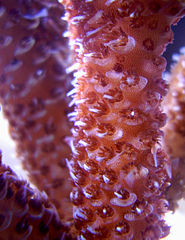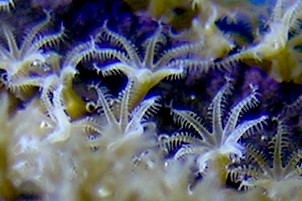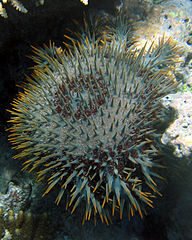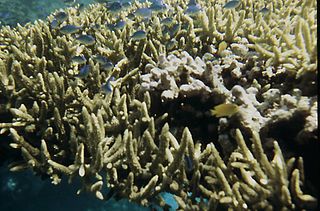Nutrition
The Crown-of-Thorns primary food source are coral polyps which can be found in coral reefs. During a study, three coral taxa, Acropora, Pocillopora, and Porites were exposed to an outbreak of Acanthaster planci, this study took place in Moorea, French Polynesia. This study found that higher densities of corals increased their survival chances by creating physical protective structures to make it more difficult for Acanthaster planci to reach its prey. These protective structures block the starfish from reach them. Acropora corals were found to be saved from elimination by utilizing these protective blocks (Coral Reefs 827-837).



Brain corals (left) are common corals found in the family Faviidae, the type of
coral that Acanthaster planci prefers to prey on. Acropora
(middle) branches off and can grow in places that can be difficult for prey
to reach. Coral polyps (right).
.jpg)
Image courtesy of Mark Strickland.
To visit his website click
here. Thank you!
During a study evaluating the feeding patterns of Acanthaster planci,
researchers indicated that of 70 species of corals exposed to the
starfish one particular stood out to be feasted on the most.
Faviidae corals were found to be the most frequently consumed coral
because their bodies are bigger than other species of coral.
Acanthaster planci prefers these bigger corals because they provide
a larger meal and are easier to access than the smaller coral that
branch off such as some Acropora corals. This study indicates
that the species of corals and their accessibility to the
Crown-of-Thorns starfish helps to understand how some coral species can
be wiped out of a population while other coral species survive an
outbreak (Coral Reefs 227-235).
Acanthaster planci feeds on corals by first moving over their prey and wrapping their arms around the coral. Next, the starfish then uses a process known as eversion. In this process the starfish feeds by forcing its stomach through its mouth and turning it inside out over its prey. The stomach then releases digestive enzymes onto the prey to begin breaking down tissue. Once broken down, Acanthaster planci will then absorb the nutrients through the walls of its stomach.
A single outbreak has the potential to wipe out entire coral species and cause massive destruction to the coral reefs that provide homes to thousands of organisms.

Coral before Acanthaster planci predation (left) and collapsed
coral skeletons after predation (right).
Now take a look at Reproduction!